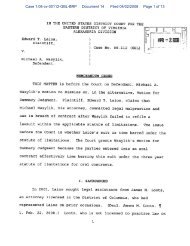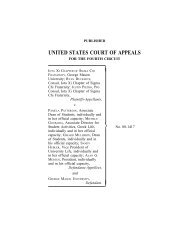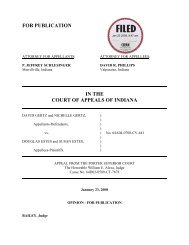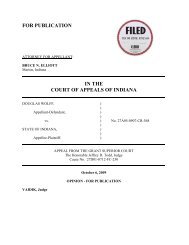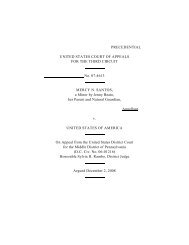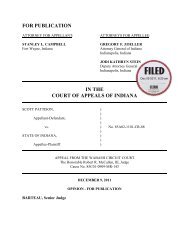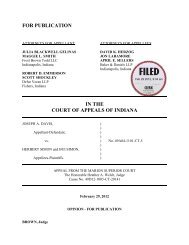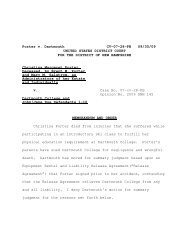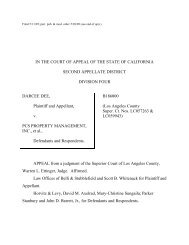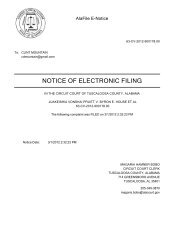in the court of appeals of the state of - Lawyers USA Online
in the court of appeals of the state of - Lawyers USA Online
in the court of appeals of the state of - Lawyers USA Online
Create successful ePaper yourself
Turn your PDF publications into a flip-book with our unique Google optimized e-Paper software.
IN THE COURT OF APPEALS OF THE STATE OF WASHINGTON<br />
DIVISION ONE<br />
PARAMJIT SINGH and HARMEET )<br />
KAUR, <strong>in</strong>dividually and as husband ) No. 61823-7-I<br />
and wife; and A.K., H.S., and A.S., )<br />
<strong>the</strong>ir m<strong>in</strong>or children, and PROVIDENCE ) DIVISON ONE<br />
HEALTH SYSTEM-WASHINGTON, )<br />
dba PROVIDENCE EVERETT ) PUBLISHED OPINION<br />
MEDICAL CENTER, a Wash<strong>in</strong>gton )<br />
corporation, )<br />
)<br />
Respondents, )<br />
)<br />
v. )<br />
)<br />
EDWARDS LIFESCIENCES )<br />
CORPORATION, a foreign corporation )<br />
do<strong>in</strong>g bus<strong>in</strong>ess <strong>in</strong> Wash<strong>in</strong>gton, ) FILED: July 6, 2009<br />
)<br />
Appellant. )<br />
Grosse, J. — Wash<strong>in</strong>gton State follows <strong>the</strong> Re<strong>state</strong>ment (Second) <strong>of</strong> Conflict <strong>of</strong><br />
Laws’ most significant relationship test <strong>in</strong> determ<strong>in</strong><strong>in</strong>g which <strong>state</strong>’s law applies to a<br />
given issue. Here, <strong>the</strong> pla<strong>in</strong>tiff underwent a heart transplant after his heart was burned<br />
as a result <strong>of</strong> a defective heart monitor used dur<strong>in</strong>g surgery <strong>in</strong> a Wash<strong>in</strong>gton hospital.<br />
The heart monitor was developed by a California based company that knew <strong>of</strong> <strong>the</strong><br />
defect, but failed to correct <strong>the</strong> defect or warn <strong>the</strong> parties <strong>of</strong> <strong>the</strong> potential problem.<br />
Even though Wash<strong>in</strong>gton has a strong policy aga<strong>in</strong>st punitive damages, it has<br />
no <strong>in</strong>terest <strong>in</strong> protect<strong>in</strong>g companies that commit fraud. Where, as here, an entity
No. 61823-7-I / 2<br />
headquartered <strong>in</strong> California, committed <strong>the</strong> conduct <strong>in</strong> California that resulted <strong>in</strong> <strong>the</strong><br />
pla<strong>in</strong>tiff’s damages, California had <strong>the</strong> greater <strong>in</strong>terest <strong>in</strong> deterr<strong>in</strong>g such fraudulent<br />
activities. We affirm.<br />
1 Ch. 19.86 RCW.<br />
FACTS<br />
Paramjit S<strong>in</strong>gh went <strong>in</strong>to Providence Everett Medical Center (Providence) <strong>in</strong><br />
October 2004 for a relatively rout<strong>in</strong>e heart bypass surgery. Dur<strong>in</strong>g surgery, an<br />
Edwards Lifesciences’ (Edwards) monitor malfunctioned, which turned <strong>of</strong>f <strong>the</strong> fail-safe<br />
devices, caus<strong>in</strong>g <strong>the</strong> Swan-Ganz ca<strong>the</strong>ter <strong>in</strong>serted <strong>in</strong>to S<strong>in</strong>gh’s heart to heat up,<br />
destroy<strong>in</strong>g his heart.<br />
After <strong>the</strong> surgery, doctors were unable to restart S<strong>in</strong>gh’s burned heart and he<br />
was kept alive with a mechanical heart device for 11 weeks. He <strong>the</strong>n received a heart<br />
transplant at <strong>the</strong> University <strong>of</strong> Wash<strong>in</strong>gton Medical Center. The drugs taken to prevent<br />
rejection <strong>of</strong> his transplanted heart caused S<strong>in</strong>gh to develop blood cancer. Currently<br />
that cancer is <strong>in</strong> remission but he is expected to cont<strong>in</strong>ue to have severe medical<br />
problems associated with both <strong>the</strong> cancer and his heart transplant.<br />
S<strong>in</strong>gh filed a products liability claim aga<strong>in</strong>st Edwards. Providence filed cross-<br />
claims aga<strong>in</strong>st <strong>the</strong> manufacturer for fraud, violation <strong>of</strong> <strong>the</strong> Consumer Protection Act<br />
(CPA), 1 and breach <strong>of</strong> contract. Both parties sought punitive damages under California<br />
law. Edwards admitted its liability for compensatory damages to <strong>the</strong> pla<strong>in</strong>tiff, but<br />
contended that Providence shared <strong>in</strong> that liability.<br />
The evidence presented at trial revealed that Edwards knew <strong>the</strong>re was a flaw <strong>in</strong><br />
<strong>the</strong> heart monitor device as early as 1998. The monitor conta<strong>in</strong>ed rogue s<strong>of</strong>tware<br />
-2-
No. 61823-7-I / 3<br />
(Layout 6) that could defeat <strong>the</strong> fail-safe triggers meant to ensure <strong>the</strong> ca<strong>the</strong>ter would<br />
not overheat. The Layout 6 s<strong>of</strong>tware had orig<strong>in</strong>ally been <strong>in</strong>stalled <strong>in</strong> an earlier model <strong>of</strong><br />
<strong>the</strong> heart monitor. The s<strong>of</strong>tware was subsequently abandoned but never removed. A<br />
July 17, 1998 memorandum from Edwards’ pr<strong>in</strong>cipal s<strong>of</strong>tware designer, Glenn Cox,<br />
noted <strong>the</strong> discovery <strong>of</strong> <strong>the</strong> bug <strong>in</strong> <strong>the</strong> s<strong>of</strong>tware. At that time, <strong>the</strong> monitor’s crash was<br />
associated with a faulty cont<strong>in</strong>uous cardiac output cable attached to a monitor with a<br />
bug <strong>in</strong> <strong>the</strong> s<strong>of</strong>tware. The solution proposed and eventually undertaken <strong>in</strong> 2006 was to<br />
remove <strong>the</strong> Layout 6 s<strong>of</strong>tware. A release <strong>of</strong> heart monitors <strong>in</strong> 2000 did not have <strong>the</strong><br />
s<strong>of</strong>tware removed.<br />
In October 2002, a ca<strong>the</strong>ter caught fire dur<strong>in</strong>g an operation <strong>in</strong> Japan. Luckily,<br />
<strong>the</strong> ca<strong>the</strong>ter had just been removed when <strong>the</strong> <strong>in</strong>cident occurred. The research <strong>in</strong><br />
California once aga<strong>in</strong> associated <strong>the</strong> heat<strong>in</strong>g <strong>of</strong> <strong>the</strong> element with <strong>the</strong> rogue s<strong>of</strong>tware,<br />
Layout 6. Edwards aga<strong>in</strong> decided <strong>in</strong> California not to recall or warn any <strong>of</strong> <strong>the</strong> users,<br />
but <strong>in</strong>stead to remove <strong>the</strong> s<strong>of</strong>tware when a monitor came back <strong>in</strong> for repair.<br />
At <strong>the</strong> time <strong>of</strong> S<strong>in</strong>gh’s surgery, Providence had eleven monitors, three <strong>of</strong> which<br />
had been repaired and no longer conta<strong>in</strong>ed <strong>the</strong> Layout 6 s<strong>of</strong>tware bug. Unfortunately,<br />
S<strong>in</strong>gh’s surgery <strong>in</strong>volved <strong>the</strong> use <strong>of</strong> a monitor that had not needed repair. At <strong>the</strong> end <strong>of</strong><br />
<strong>the</strong> surgery, surgeons discovered <strong>the</strong> damage only after try<strong>in</strong>g to take S<strong>in</strong>gh <strong>of</strong>f bypass.<br />
In June 2006, Edwards recalled <strong>the</strong> monitor after an extensive <strong>in</strong>vestigation by<br />
<strong>the</strong> United States Food and Drug Adm<strong>in</strong>istration (FDA). Edwards admitted <strong>the</strong> monitor<br />
malfunctioned dur<strong>in</strong>g S<strong>in</strong>gh’s operation. In August 2007, Edwards admitted that Layout<br />
6 was a proximate cause <strong>of</strong> <strong>in</strong>jury to S<strong>in</strong>gh. On January 18, 2008, Edwards admitted its<br />
-3-
No. 61823-7-I / 4<br />
liability for compensatory damages to S<strong>in</strong>gh, but contended that Providence shared <strong>in</strong><br />
that liability by its use <strong>of</strong> a defective cable with <strong>the</strong> monitor.<br />
The jury returned a verdict <strong>in</strong> favor <strong>of</strong> <strong>the</strong> S<strong>in</strong>gh family for $31,750,000 and<br />
awarded punitive damages under California law. The jury allocated 99.9 percent <strong>of</strong> <strong>the</strong><br />
fault to Edwards and 0.1 percent <strong>of</strong> <strong>the</strong> fault to Providence. The jury awarded<br />
Providence compensatory damages <strong>in</strong> <strong>the</strong> amount <strong>of</strong> $210,000. The jury also found<br />
that Edwards’ conduct was malicious and, under California law, 2 awarded punitive<br />
damages <strong>in</strong> <strong>the</strong> amount <strong>of</strong> $8,350,000 to S<strong>in</strong>gh and $100,000 to Providence. In<br />
addition to <strong>the</strong> compensatory damages awarded to S<strong>in</strong>gh and his family, <strong>the</strong> jury found<br />
Edwards had committed fraud, violated <strong>the</strong> CPA, and breached its contracts with<br />
Providence.<br />
Edwards <strong>appeals</strong>, argu<strong>in</strong>g that punitive damages should not have been<br />
awarded, and that <strong>the</strong> evidence support<strong>in</strong>g punitive damages was so entw<strong>in</strong>ed with <strong>the</strong><br />
evidence support<strong>in</strong>g <strong>the</strong> compensatory damages that <strong>the</strong> amount awarded for <strong>the</strong><br />
compensatory damages was higher than it o<strong>the</strong>rwise would have been. Edwards also<br />
argues that <strong>the</strong> jury <strong>in</strong>struction on <strong>in</strong>surance should not have been given.<br />
Choice <strong>of</strong> Law<br />
ANALYSIS<br />
In resolv<strong>in</strong>g conflict <strong>of</strong> law tort questions, Wash<strong>in</strong>gton has abandoned <strong>the</strong> lex<br />
loci delicti rule and follows <strong>the</strong> Re<strong>state</strong>ment (Second) <strong>of</strong> Conflict <strong>of</strong> Laws’ most<br />
significant relationship test. 3 Where a conflict exists, Wash<strong>in</strong>gton <strong>court</strong>s decide which<br />
2 Cal. Civ. Code § 3294.<br />
3 Johnson v. Spider Stag<strong>in</strong>g Corp, 87 Wn.2d 577, 580, 555 P.2d 997 (1976).<br />
-4-
No. 61823-7-I / 5<br />
law applies by determ<strong>in</strong><strong>in</strong>g which jurisdiction has <strong>the</strong> most significant relationship to a<br />
given issue. 4 The <strong>court</strong> “must evaluate <strong>the</strong> contacts both quantitatively and<br />
qualitatively, based upon <strong>the</strong> location <strong>of</strong> <strong>the</strong> most significant contacts as <strong>the</strong>y relate to<br />
<strong>the</strong> particular issue at hand.” 5 The contacts to be evaluated for <strong>the</strong>ir relative importance<br />
to <strong>the</strong> issue were set forth <strong>in</strong> Johnson v. Spider Stag<strong>in</strong>g Corp.: 6<br />
(a) <strong>the</strong> place where <strong>the</strong> <strong>in</strong>jury occurred,<br />
(b) <strong>the</strong> place where <strong>the</strong> conduct caus<strong>in</strong>g <strong>the</strong> <strong>in</strong>jury occurred,<br />
(c) <strong>the</strong> domicile, residence, nationality, place <strong>of</strong> <strong>in</strong>corporation and place <strong>of</strong><br />
bus<strong>in</strong>ess <strong>of</strong> <strong>the</strong> parties, and<br />
(d) <strong>the</strong> place where <strong>the</strong> relationship, if any, between <strong>the</strong> parties is<br />
centered.<br />
In Johnson, scaffold<strong>in</strong>g designed and manufactured <strong>in</strong> Wash<strong>in</strong>gton collapsed <strong>in</strong><br />
Kansas, caus<strong>in</strong>g <strong>the</strong> death <strong>of</strong> a Kansas resident. The conflict <strong>of</strong> law issue was whe<strong>the</strong>r<br />
Wash<strong>in</strong>gton’s law, which allowed unlimited recovery <strong>in</strong> wrongful death actions, or<br />
Kansas law which imposed a $50,000 ceil<strong>in</strong>g, should apply. In hold<strong>in</strong>g that<br />
Wash<strong>in</strong>gton law applied, <strong>the</strong> Johnson <strong>court</strong> enunciated a two-step analysis to be<br />
employed to determ<strong>in</strong>e <strong>the</strong> appropriate choice <strong>of</strong> law. The <strong>court</strong> must first evaluate <strong>the</strong><br />
contacts with each potentially <strong>in</strong>terested <strong>state</strong> and <strong>the</strong>n if balanced, evaluate <strong>the</strong> public<br />
policies and governmental <strong>in</strong>terests <strong>of</strong> <strong>the</strong> concerned <strong>state</strong>s. The <strong>court</strong> <strong>in</strong> Johnson<br />
concluded without fur<strong>the</strong>r comment that <strong>the</strong> contacts were “evenly balanced.” 7 The<br />
Johnson <strong>court</strong> also considered <strong>the</strong> parties’ justified expectations. 8 The Wash<strong>in</strong>gton<br />
4 Zenaida-Garcia v. Recovery Systems Tech., Inc., 128 Wn. App. 256, 115 P.3d 1017<br />
(2005), rev. denied, 156 Wn.2d 1026, 132 P.3d 1094 (2006).<br />
5 Mart<strong>in</strong> v. Goodyear Tire & Rubber Co., 114 Wn. App. 823, 830, 61 P.3d 1196 (2003)<br />
(cit<strong>in</strong>g Johnson, 87 Wn.2d at 581).<br />
6 87 Wn.2d 577, 581, 555 P.2d 997 (1976) (cit<strong>in</strong>g Re<strong>state</strong>ment (Second) <strong>of</strong> Conflict <strong>of</strong><br />
Laws § 6).<br />
7 Johnson, 87 Wn.2d at 582.<br />
8 See Potlatch No. 1 Fed. Credit Union v. Kennedy, 76 Wn.2d 806, 812-13, 459 P.2d<br />
-5-
No. 61823-7-I / 6<br />
corporation sold its products <strong>in</strong> all 50 <strong>state</strong>s, only a few <strong>of</strong> which had wrongful death<br />
limitations. Thus, <strong>the</strong> manufacturer “could not have justifiably relied on <strong>the</strong> Kansas<br />
limitation.” 9 Conflict <strong>of</strong> law analysis <strong>in</strong> Wash<strong>in</strong>gton is thus a hybrid <strong>of</strong> <strong>the</strong> Re<strong>state</strong>ment<br />
(Second) <strong>of</strong> Conflict <strong>of</strong> Laws and a governmental <strong>in</strong>terest analysis.<br />
Wash<strong>in</strong>gton <strong>court</strong>s have held that <strong>the</strong>se same choice <strong>of</strong> law pr<strong>in</strong>ciples apply to<br />
<strong>the</strong> issue <strong>of</strong> punitive damages. In Kammerer v. Western Gear Corp., 10 <strong>the</strong> <strong>court</strong><br />
permitted a Wash<strong>in</strong>gton jury to award punitive damages aga<strong>in</strong>st a Wash<strong>in</strong>gton<br />
corporation, apply<strong>in</strong>g California law to a claim based on fraudulent representation. In<br />
so hold<strong>in</strong>g, <strong>the</strong> <strong>court</strong> noted:<br />
“California has an <strong>in</strong>terest <strong>in</strong> deterr<strong>in</strong>g fraudulent activities by<br />
corporations hav<strong>in</strong>g a substantial bus<strong>in</strong>ess presence with<strong>in</strong> its borders.<br />
Wash<strong>in</strong>gton has no <strong>in</strong>terest <strong>in</strong> protect<strong>in</strong>g persons who commit fraud.<br />
Western Gear asserts that differences <strong>in</strong> Wash<strong>in</strong>gton and California law<br />
govern<strong>in</strong>g fraud suggest that Wash<strong>in</strong>gton has a policy <strong>of</strong> greater caution<br />
<strong>in</strong> allow<strong>in</strong>g judgments for fraud. Because we do not f<strong>in</strong>d any difference,<br />
material to this case, <strong>in</strong> <strong>the</strong> laws <strong>of</strong> <strong>the</strong> two <strong>state</strong>s, we do not f<strong>in</strong>d any<br />
<strong>in</strong>terest served by application <strong>of</strong> Wash<strong>in</strong>gton law. Because Wash<strong>in</strong>gton<br />
has no <strong>in</strong>terests superior to or <strong>in</strong>consistent with <strong>the</strong> <strong>in</strong>terests <strong>of</strong> California<br />
<strong>in</strong> this controversy, application <strong>of</strong> <strong>the</strong> Re<strong>state</strong>ment rule dictates that<br />
California law govern <strong>the</strong> Kammerers’ claim for fraud.” [11]<br />
The significant factor <strong>in</strong> Kammerer was <strong>the</strong> jurisdiction <strong>in</strong> which <strong>the</strong> bad<br />
behavior—fraudulent misrepresentation—occurred.<br />
In Barr v. Interbay Citizens Bank, 12 a companion case issued on <strong>the</strong> same day<br />
as Kammerer, <strong>the</strong> Supreme Court rejected <strong>the</strong> application <strong>of</strong> Florida’s punitive<br />
32 (1969).<br />
9 Johnson, 87 Wn.2d at 583 n.3.<br />
10 96 Wn.2d 416, 635 P.2d 708 (1981).<br />
11 Kammerer, 96 Wn.2d at 416 (quot<strong>in</strong>g Kammerer v. Western Gear Corp., 27 Wn. App.<br />
512, 520-21, 618 P.2d 1330 (1980)).<br />
12 96 Wn.2d 692, 635 P.2d 441 (1982).<br />
-6-
No. 61823-7-I / 7<br />
damages because <strong>the</strong> conduct that warranted <strong>the</strong> punitive damages occurred <strong>in</strong><br />
Nevada and Wash<strong>in</strong>gton. The Florida lender hired agents <strong>in</strong> Nevada to travel to<br />
Wash<strong>in</strong>gton to repossess George Barr’s automobile. Barr sued for conversion, seek<strong>in</strong>g<br />
punitive damages under Florida law. The Supreme Court recognized Florida’s<br />
legitimate <strong>in</strong>terest <strong>in</strong> impos<strong>in</strong>g punitive damages, but rejected Florida as <strong>the</strong> <strong>state</strong> with<br />
<strong>the</strong> most significant relationship:<br />
The <strong>in</strong>terest <strong>in</strong> Florida <strong>in</strong> provid<strong>in</strong>g an example for deterrence would not<br />
be fur<strong>the</strong>red when <strong>the</strong> actual conduct and <strong>the</strong> acts which might warrant<br />
punitive damages were restricted to Nevada and Wash<strong>in</strong>gton. [13]<br />
In Barr, <strong>the</strong> crux <strong>of</strong> <strong>the</strong> compla<strong>in</strong>t was not <strong>the</strong> decision to repossess <strong>the</strong> car (purchased<br />
<strong>in</strong> Florida) but ra<strong>the</strong>r <strong>the</strong> method used to repossess that car.<br />
A recent decision <strong>of</strong> this <strong>court</strong>, Zenaida-Garcia v. Recovery Systems<br />
Technology, Inc., 14 applied Wash<strong>in</strong>gton product liability law. There, a fatal <strong>in</strong>dustrial<br />
accident <strong>in</strong> Oregon was caused by a defective mach<strong>in</strong>e manufactured <strong>in</strong> Wash<strong>in</strong>gton.<br />
In determ<strong>in</strong><strong>in</strong>g which statute <strong>of</strong> repose would apply—Oregon’s 8-year or Wash<strong>in</strong>gton’s<br />
12-year—<strong>the</strong> <strong>court</strong> reiterated Johnson’s mantra that although <strong>the</strong>re is a presumption<br />
that <strong>the</strong> law <strong>of</strong> <strong>the</strong> place <strong>of</strong> <strong>in</strong>jury applies <strong>in</strong> personal <strong>in</strong>jury cases, that presumption is<br />
overcome if ano<strong>the</strong>r <strong>state</strong> has a greater <strong>in</strong>terest <strong>in</strong> <strong>the</strong> determ<strong>in</strong>ation <strong>of</strong> that particular<br />
issue. The Zenaida-Garcia <strong>court</strong> applied Wash<strong>in</strong>gton’s law. In its hold<strong>in</strong>g, <strong>the</strong> <strong>court</strong><br />
noted that <strong>the</strong> defendant was a Wash<strong>in</strong>gton corporation that designed <strong>the</strong> equipment.<br />
The cause <strong>of</strong> <strong>the</strong> action was <strong>the</strong> negligent and unsafe design, thus center<strong>in</strong>g <strong>the</strong><br />
relationship <strong>in</strong> Wash<strong>in</strong>gton. Hold<strong>in</strong>g that <strong>the</strong> contacts were evenly balanced, <strong>the</strong> <strong>court</strong><br />
13 Barr, 96 Wn.2d at 699.<br />
14 128 Wn. App. 256, 115 P.3d 1017 (2005).<br />
-7-
No. 61823-7-I / 8<br />
weighed <strong>the</strong> policy <strong>in</strong>terests <strong>of</strong> <strong>the</strong> two <strong>state</strong>s <strong>in</strong> hav<strong>in</strong>g its statute <strong>of</strong> repose govern and<br />
apply. 15 Wash<strong>in</strong>gton’s statute <strong>of</strong> repose expressed a policy <strong>of</strong> deterrence <strong>of</strong> tortious<br />
conduct which encouraged manufacturers to make safe products for consumers.<br />
Oregon had no <strong>in</strong>terest <strong>in</strong> protect<strong>in</strong>g a Wash<strong>in</strong>gton corporation and <strong>in</strong>deed no such<br />
rule protects Oregon citizens. “The extent <strong>of</strong> <strong>the</strong> <strong>in</strong>terest <strong>of</strong> each potentially <strong>in</strong>terested<br />
<strong>state</strong> should be determ<strong>in</strong>ed on <strong>the</strong> basis, among o<strong>the</strong>r th<strong>in</strong>gs, <strong>of</strong> <strong>the</strong> purpose sought to<br />
be achieved by <strong>the</strong>ir relevant local law rules and <strong>the</strong> particular issue <strong>in</strong>volved.” 16<br />
Here, Edwards argues that <strong>the</strong> methodology employed by <strong>the</strong> trial <strong>court</strong> to<br />
determ<strong>in</strong>e that California law applied was <strong>in</strong>correct because <strong>the</strong> sheer number <strong>of</strong><br />
contacts with Wash<strong>in</strong>gton warranted application <strong>of</strong> its law. But if <strong>the</strong> particular conduct<br />
is viewed as it is <strong>in</strong> Kammerer, Barr, and Zenaida-Garcia, <strong>the</strong> conduct which resulted <strong>in</strong><br />
<strong>the</strong> <strong>in</strong>jury occurred <strong>in</strong> California. Edwards’ corporate headquarters are located <strong>in</strong><br />
California and <strong>the</strong> defect <strong>in</strong> <strong>the</strong> s<strong>of</strong>tware was discovered <strong>in</strong> California as early as 1998.<br />
And by 2002, <strong>the</strong> foreseeable heat<strong>in</strong>g <strong>of</strong> <strong>the</strong> ca<strong>the</strong>ter <strong>in</strong> a surgical sett<strong>in</strong>g was known by<br />
Edwards and aga<strong>in</strong> <strong>the</strong> decision was made <strong>in</strong> California not to recall or warn users.<br />
Had <strong>the</strong> warn<strong>in</strong>g been given, Providence could have used one <strong>of</strong> <strong>the</strong> three “repaired”<br />
monitors for its bypass surgeries and S<strong>in</strong>gh would not have been <strong>in</strong>jured. Fur<strong>the</strong>r, <strong>the</strong><br />
operator’s manual direct<strong>in</strong>g <strong>the</strong> surgeon to use <strong>the</strong> bolus or cool method was written <strong>in</strong><br />
California.<br />
Edwards’ reliance on Mart<strong>in</strong> v. Good Year Tire & Rubber Co. 17 and Rice v. Dow<br />
15 Zenaida-Garcia, 128 Wn. App. at 263.<br />
16 Southwell v. Wid<strong>in</strong>g Transp., Inc., 101 Wn.2d 200, 204, 676 P.2d 477 (1984) (cit<strong>in</strong>g<br />
Johnson, 87 Wn.2d at 582).<br />
17 114 Wn. App. 823, 829-30, 61 P.3d 1196 (2003).<br />
-8-
No. 61823-7-I / 9<br />
Chemical Co. 18 for <strong>the</strong> proposition that <strong>the</strong> <strong>in</strong>jury occurred <strong>in</strong> Wash<strong>in</strong>gton is<br />
unpersuasive. Although <strong>the</strong>re is presumption that <strong>the</strong> law <strong>of</strong> <strong>the</strong> <strong>state</strong> where <strong>the</strong> <strong>in</strong>jury<br />
occurred applies <strong>in</strong> personal <strong>in</strong>jury cases, this presumption may be overcome if ano<strong>the</strong>r<br />
<strong>state</strong> has a greater <strong>in</strong>terest <strong>in</strong> determ<strong>in</strong>ation <strong>of</strong> a particular issue. 19 In Mart<strong>in</strong>, unlike<br />
here, <strong>the</strong> defendant’s contacts with Oregon were non-existent. In Rice, <strong>the</strong> pla<strong>in</strong>tiff<br />
developed leukemia after exposure to herbicides manufactured by Dow Chemical<br />
Company. 20 The <strong>court</strong> held that Oregon law applied, not Wash<strong>in</strong>gton law, because <strong>the</strong><br />
only Wash<strong>in</strong>gton contact was <strong>the</strong> pla<strong>in</strong>tiff’s residency. The Rice <strong>court</strong> reiterated that<br />
“[t]he old rule that <strong>the</strong> law <strong>of</strong> <strong>the</strong> place <strong>of</strong> <strong>the</strong> wrong governs <strong>the</strong> action has been<br />
rejected for <strong>the</strong> ‘most significant relationship’ rule.” 21<br />
In analyz<strong>in</strong>g which <strong>state</strong> has <strong>the</strong> greater governmental policy <strong>in</strong>terest, Edwards<br />
contends that it is Wash<strong>in</strong>gton with its policy that rejects <strong>the</strong> award <strong>of</strong> punitive damages<br />
unless provided for by statute. Edwards argues that Wash<strong>in</strong>gton’s <strong>in</strong>terest is <strong>in</strong><br />
permitt<strong>in</strong>g full compensation for <strong>in</strong>jured parties and none <strong>in</strong> permitt<strong>in</strong>g a w<strong>in</strong>dfall for<br />
pla<strong>in</strong>tiffs. But, as already noted, Wash<strong>in</strong>gton <strong>court</strong>s have allowed punitive damages <strong>in</strong><br />
o<strong>the</strong>r cases. In Kammerer, <strong>in</strong> particular, <strong>the</strong> <strong>court</strong> explicitly <strong>state</strong>d that Wash<strong>in</strong>gton has<br />
no <strong>in</strong>terest <strong>in</strong> protect<strong>in</strong>g companies who commit fraud. The conduct that serves as <strong>the</strong><br />
basis <strong>of</strong> <strong>the</strong> punitive damage award here occurred <strong>in</strong> California and that <strong>state</strong> has an<br />
<strong>in</strong>terest <strong>in</strong> deterr<strong>in</strong>g its corporations from engag<strong>in</strong>g <strong>in</strong> such fraudulent conduct.<br />
Com<strong>in</strong>gl<strong>in</strong>g <strong>of</strong> Evidence<br />
18 124 Wn.2d 205, 215, 875 P.2d 1213 (1994).<br />
19 Mart<strong>in</strong>, 114 Wn. App. at 830; Re<strong>state</strong>ment (Second) Conflicts <strong>of</strong> Laws § 146.<br />
20 Rice, 124 Wn.2d at 205.<br />
21 Rice, 124 Wn.2d at 215 (quot<strong>in</strong>g Johnson, 87 Wn.2d at 580).<br />
-9-
No. 61823-7-I / 10<br />
The jury’s verdict was well with<strong>in</strong> <strong>the</strong> evidence presented. Because <strong>of</strong> Edwards<br />
conduct, S<strong>in</strong>gh’s heart was irreparably burned. He was <strong>in</strong> a coma for over 11 weeks.<br />
He suffered anoxic bra<strong>in</strong> damage and underwent a heart transplant. S<strong>in</strong>gh developed<br />
blood cancer as a result <strong>of</strong> <strong>the</strong> anti-rejection drugs and underwent chemo<strong>the</strong>rapy. He<br />
is slated for kidney dialysis and needs a kidney transplant <strong>in</strong> <strong>the</strong> near future. He has a<br />
significant risk <strong>of</strong> future cancers, <strong>in</strong>clud<strong>in</strong>g a recurrence <strong>of</strong> <strong>the</strong> blood cancer, as well as<br />
a significant risk <strong>of</strong> need<strong>in</strong>g ano<strong>the</strong>r heart transplant, but he will probably not be<br />
physically eligible for that surgery.<br />
Evidence <strong>of</strong> S<strong>in</strong>gh’s economic damages for medical bills was estimated at<br />
$2,697,230, which does not <strong>in</strong>clude an anticipated second heart transplant. In list<strong>in</strong>g<br />
<strong>the</strong> non-economic damages, S<strong>in</strong>gh argued for <strong>the</strong> follow<strong>in</strong>g:<br />
·<br />
·<br />
·<br />
S<strong>in</strong>gh - $24,397,230<br />
Wife - $9,500,000<br />
Children - $1,000,000 (each)<br />
Dr. Lowell Basset, an economist, calculated <strong>the</strong> present value and future care<br />
costs <strong>of</strong> S<strong>in</strong>gh. Edwards did not call any witnesses to counter <strong>the</strong> damages and<br />
<strong>in</strong>juries suffered by <strong>the</strong> S<strong>in</strong>gh family. Evidence was <strong>in</strong>troduced that Edwards had gross<br />
revenues over a billion dollars and a net worth over 835 million. The <strong>court</strong> <strong>in</strong>structed<br />
<strong>the</strong> jury that Edwards’ revenues were not to be considered <strong>in</strong> award<strong>in</strong>g damages.<br />
When Dr. Basset completed his testimony regard<strong>in</strong>g <strong>the</strong> compensatory<br />
damages, and before he was questioned regard<strong>in</strong>g punitive damages and any<br />
monetary evaluation <strong>of</strong> those damages, <strong>the</strong> jury was given a limit<strong>in</strong>g <strong>in</strong>struction<br />
advis<strong>in</strong>g <strong>the</strong>m <strong>the</strong> ensu<strong>in</strong>g evidence was only to be considered if <strong>the</strong> jury first<br />
-10-
No. 61823-7-I / 11<br />
determ<strong>in</strong>ed that <strong>the</strong>re was a basis for an award <strong>of</strong> punitive damages; such evidence<br />
was not to be considered for any o<strong>the</strong>r purpose or with regard to any o<strong>the</strong>r issues. The<br />
awarded punitive damages <strong>of</strong> $8,350,000 were one percent <strong>of</strong> Edwards’ net worth—a<br />
quarter <strong>of</strong> <strong>the</strong> compensatory damages. This is evidence that <strong>the</strong> jury’s award was not a<br />
runaway verdict.<br />
Both Providence and S<strong>in</strong>gh <strong>of</strong>fered to try S<strong>in</strong>gh’s and Providence’s<br />
compensatory claims <strong>in</strong> one trial phase, with a second phase reserved to deal with <strong>the</strong><br />
issue <strong>of</strong> “malice,” an element required under California law. Edwards decl<strong>in</strong>ed.<br />
Edwards admitted that it was at fault, but only partially. Edwards argued that<br />
Providence negligently failed to discard a defective cable. The evidence presented at<br />
trial <strong>in</strong>dicated that <strong>the</strong> cable used <strong>in</strong> <strong>the</strong> surgery had one prong that was less than a<br />
millimeter shorter than <strong>the</strong> o<strong>the</strong>rs. These are factual issues for <strong>the</strong> jury, which decided<br />
that Edwards was 99.9 percent liable. The fact that Providence’s liability was only 0.1<br />
percent does not negate <strong>the</strong> judgment.<br />
Much <strong>of</strong> <strong>the</strong> evidence that Edwards argues should have been excluded was<br />
relevant to both <strong>the</strong> compensatory claims as well as Edwards’ contention that fault<br />
should be allocated to Providence. Edwards’ motion to trifurcate <strong>the</strong> trial was denied<br />
earlier. Indeed, after presid<strong>in</strong>g over <strong>the</strong> trial, <strong>the</strong> <strong>court</strong> remarked that its <strong>in</strong>itial decision<br />
to not trifurcate was validated after hear<strong>in</strong>g all <strong>of</strong> <strong>the</strong> evidence presented.<br />
In deny<strong>in</strong>g Edwards’ motion for a new trial, <strong>the</strong> trial <strong>court</strong> noted that <strong>the</strong> jury<br />
verdict was less than <strong>the</strong> pla<strong>in</strong>tiffs’ sought and more than Edwards had proposed. The<br />
trial <strong>court</strong> found that <strong>the</strong> jury verdict showed restra<strong>in</strong>t <strong>in</strong> its award <strong>of</strong> punitive damages.<br />
-11
No. 61823-7-I / 12<br />
The only evidence that could possibly be considered prejudicial was <strong>the</strong><br />
<strong>in</strong>troduction <strong>of</strong> Edwards’ wealth. But any objection to its admission was waived when<br />
Edwards elected to not separate punitive from compensatory damages. Fur<strong>the</strong>r, <strong>the</strong><br />
trial <strong>court</strong> issued limit<strong>in</strong>g <strong>in</strong>structions both pretrial and posttrial, admonish<strong>in</strong>g <strong>the</strong> jury<br />
that it should not consider Edwards’ wealth and post-accident conduct <strong>in</strong> determ<strong>in</strong><strong>in</strong>g<br />
<strong>the</strong> S<strong>in</strong>gh’s compensatory claims.<br />
Edwards does not cite to <strong>the</strong> particular <strong>in</strong>formation that is so prejudicial or <strong>the</strong><br />
<strong>in</strong>formation which should not have been admitted <strong>in</strong>to evidence. As noted <strong>in</strong> its denial<br />
<strong>of</strong> Edwards’ motion, <strong>the</strong> <strong>court</strong> <strong>state</strong>d:<br />
O<strong>the</strong>r than <strong>the</strong> wealth issue, it’s very hard, given that we’re try<strong>in</strong>g<br />
allocation <strong>of</strong> liability and Providence’s claims toge<strong>the</strong>r to see what it is<br />
that came <strong>in</strong> that wouldn’t o<strong>the</strong>rwise have come <strong>in</strong> anyway. The jury was<br />
clearly <strong>in</strong>structed as to what <strong>the</strong>y could consider – what issues <strong>the</strong>y<br />
considered for <strong>the</strong> evidence on at trial, and both at <strong>the</strong> beg<strong>in</strong>n<strong>in</strong>g and at<br />
<strong>the</strong> end, and <strong>the</strong>y were gett<strong>in</strong>g limit<strong>in</strong>g <strong>in</strong>structions. And so <strong>the</strong> Court<br />
does not f<strong>in</strong>d prejudice related to its failure to trifurcate <strong>the</strong> trial, and<br />
certa<strong>in</strong>ly does not feel <strong>the</strong>re’s a need for a new trial because <strong>of</strong> that.<br />
The trial <strong>court</strong> had various tools to <strong>in</strong>sure that any prejudice to Edwards <strong>in</strong><br />
allow<strong>in</strong>g a punitive damage claim to go forward did not affect <strong>the</strong> liability portion <strong>of</strong> <strong>the</strong><br />
trial. Here, <strong>the</strong> trial <strong>court</strong> used those tools with its limit<strong>in</strong>g <strong>in</strong>structions and verdict<br />
forms.<br />
Jury Instruction<br />
The <strong>court</strong> reviews jury <strong>in</strong>structions de novo. 22 The Wash<strong>in</strong>gton Supreme Court<br />
summarized <strong>the</strong> standard <strong>of</strong> review for jury <strong>in</strong>structions <strong>in</strong> Keller v. City <strong>of</strong> Spokane: 23<br />
“Jury <strong>in</strong>structions are sufficient when <strong>the</strong>y allow counsel to argue <strong>the</strong>ir<br />
22 Thompson v. K<strong>in</strong>g Feed & Nutrition Serv., Inc., 153 Wn.2d 447, 453, 105 P.3d 378<br />
(2005).<br />
23 146 Wn.2d 237, 249-50, 44 P.3d 845 (2002) (<strong>in</strong>ternal citations omitted).<br />
-12-
No. 61823-7-I / 13<br />
24 Micro Enhancement Intern., Inc. v. Coopers & Lybrand, LLP, 110 Wn. App. 412, 430,<br />
40 P.3d 1206 (2002).<br />
25 6 Wash<strong>in</strong>gton Practice: Wash<strong>in</strong>gton Pattern Jury Instructions: Civil 2.13, at 49 (5th<br />
ed. 2005).<br />
<strong>the</strong>ory <strong>of</strong> <strong>the</strong> case, are not mislead<strong>in</strong>g, and when read as a whole<br />
properly <strong>in</strong>form <strong>the</strong> trier <strong>of</strong> fact <strong>of</strong> <strong>the</strong> applicable law.” Even if an<br />
<strong>in</strong>struction is mislead<strong>in</strong>g, it will not be reversed unless prejudice is shown.<br />
But where a jury <strong>in</strong>struction correctly <strong>state</strong>s <strong>the</strong> law, as here, “<strong>the</strong> <strong>court</strong>’s decision to<br />
give <strong>the</strong> <strong>in</strong>struction will not be disturbed absent an abuse <strong>of</strong> discretion.” 24<br />
Instruction 11 provides:<br />
You must not discuss or speculate about whe<strong>the</strong>r any party has <strong>in</strong>surance<br />
or o<strong>the</strong>r coverage available. Whe<strong>the</strong>r a party does or does not have<br />
<strong>in</strong>surance has no bear<strong>in</strong>g on any issue that you must decide. You are not<br />
to make, decl<strong>in</strong>e to make, <strong>in</strong>crease, or decrease any award because you<br />
believe that a party does or does not have medical <strong>in</strong>surance, workers’<br />
compensation, liability <strong>in</strong>surance, or some o<strong>the</strong>r form <strong>of</strong> coverage.<br />
The <strong>in</strong>struction is based on Wash<strong>in</strong>gton Pattern Jury Instructions (WPI) 2.13. The<br />
Wash<strong>in</strong>gton Supreme Court’s Committee on Pattern Jury Instructions recommended<br />
that this <strong>in</strong>struction be given when <strong>the</strong> <strong>court</strong> was concerned that jurors might speculate<br />
about <strong>in</strong>surance or o<strong>the</strong>r sources <strong>of</strong> fund<strong>in</strong>g. 25<br />
Here, <strong>the</strong>re was evidence that <strong>the</strong> jurors were speculat<strong>in</strong>g about <strong>in</strong>surance. The<br />
issue was raised <strong>in</strong> voir dire by a potential juror who expla<strong>in</strong>ed that <strong>in</strong>surance had paid<br />
for his employee’s heart transplant. Fur<strong>the</strong>r, a juror posed a question dur<strong>in</strong>g trial about<br />
whe<strong>the</strong>r or not S<strong>in</strong>gh had any <strong>in</strong>surance. Although <strong>the</strong> <strong>court</strong> properly refused to ask<br />
<strong>the</strong> juror’s question, <strong>the</strong> exchange does <strong>in</strong>dicate that <strong>the</strong> jury or at least one juror was<br />
consider<strong>in</strong>g <strong>in</strong>surance.<br />
Edwards argues that <strong>in</strong>struction 11 was unwarranted. Edwards cites to a 1934<br />
-13-
No. 61823-7-I / 14<br />
case, Graves v. Mickel, 26 to support its position that <strong>the</strong> giv<strong>in</strong>g <strong>of</strong> such an <strong>in</strong>struction<br />
may be prejudicial <strong>in</strong> and <strong>of</strong> itself. But Graves is dist<strong>in</strong>guishable. There, <strong>the</strong> <strong>court</strong><br />
found <strong>the</strong>re was noth<strong>in</strong>g <strong>in</strong> <strong>the</strong> record which would give sufficient reason to pr<strong>of</strong>fer such<br />
an <strong>in</strong>struction. 27 This is not <strong>the</strong> case here. Moreover, <strong>in</strong>surance is more prevalent<br />
today than it was <strong>in</strong> 1934 and thus less likely to be prejudicial.<br />
Clos<strong>in</strong>g Argument<br />
Edwards objects to S<strong>in</strong>gh’s attorneys referr<strong>in</strong>g to <strong>the</strong> <strong>in</strong>struction dur<strong>in</strong>g oral<br />
argument, contend<strong>in</strong>g that such argument was prejudicial because it called attention to<br />
Edwards hav<strong>in</strong>g <strong>in</strong>surance. But <strong>the</strong>re was no objection raised at that time. Moreover,<br />
attorneys are permitted to refer to <strong>in</strong>structions dur<strong>in</strong>g argument. Equally evident is <strong>the</strong><br />
possibility that such an <strong>in</strong>struction called attention to <strong>the</strong> possibility that S<strong>in</strong>gh was<br />
covered by <strong>in</strong>surance. The <strong>state</strong>ment that “it would be unfair to Edwards” at most<br />
could be construed to rem<strong>in</strong>d <strong>the</strong> jury that whe<strong>the</strong>r S<strong>in</strong>gh or Edwards had <strong>in</strong>surance<br />
was not someth<strong>in</strong>g that should be factored <strong>in</strong>to <strong>the</strong>ir verdict. The jury is presumed to<br />
follow <strong>the</strong> <strong>court</strong>’s <strong>in</strong>structions. 28 There was no improper <strong>state</strong>ment <strong>in</strong> that <strong>in</strong>struction.<br />
Improper Question<br />
Edwards also contends on appeal that <strong>the</strong> trial <strong>court</strong> abused its discretion <strong>in</strong><br />
deny<strong>in</strong>g Edwards’ motion for a new trial because <strong>of</strong> an improper question dur<strong>in</strong>g trial.<br />
A witness was asked whe<strong>the</strong>r he was aware that S<strong>in</strong>gh was not su<strong>in</strong>g or seek<strong>in</strong>g<br />
reimbursement from Providence. The follow<strong>in</strong>g exchange occurred dur<strong>in</strong>g S<strong>in</strong>gh’s<br />
26 176 Wash. 329, 29 P.2d 405 (1934).<br />
27 Graves, 176 Wash. at 337.<br />
28 A.C. ex rel. Cooper v. Bell<strong>in</strong>gham Sch. Dist., 125 Wn. App. 511, 521-22, 105 P.3d<br />
400 (2004); Carnation Co., Inc. v. Hill, 115 Wn.2d 184, 186-87, 796 P.2d 416 (1990).<br />
-14-
No. 61823-7-I / 15<br />
cross-exam<strong>in</strong>ation <strong>of</strong> Providence’s Chief Executive Officer (CEO) David Brooks:<br />
Q. Hi. Mr. Brooks. How are you?<br />
A. Good morn<strong>in</strong>g.<br />
Q. We met, but we really haven’t talked, have we?<br />
A. No<br />
Q. You talked about a lawsuit, su<strong>in</strong>g <strong>in</strong> this case, <strong>the</strong> hospital su<strong>in</strong>g<br />
<strong>in</strong> this case, correct?<br />
A. Yes<br />
Q. You are aware <strong>of</strong> <strong>the</strong> fact that <strong>the</strong> S<strong>in</strong>gh family is not su<strong>in</strong>g <strong>the</strong><br />
hospital and cannot collect from <strong>the</strong> hospital?<br />
A. I am.<br />
Q. Okay. Now, as <strong>the</strong> CEO <strong>of</strong> Providence, can you tell me whe<strong>the</strong>r<br />
you are as high as it can go with<strong>in</strong> – we talked about various vice<br />
presidents and so on <strong>in</strong> corporations, you are at <strong>the</strong> top, are you<br />
not, with <strong>the</strong> board?<br />
-15
No. 61823-7-I / 16<br />
Edwards did not object at trial. An objection after a question has been answered is too<br />
late. 29 Fur<strong>the</strong>rmore, <strong>in</strong> its rul<strong>in</strong>g deny<strong>in</strong>g <strong>the</strong> motion for new trial, <strong>the</strong> trial <strong>court</strong> noted<br />
that Edwards had opened <strong>the</strong> door <strong>in</strong> its open<strong>in</strong>g <strong>state</strong>ment when it made reference to<br />
Providence pay<strong>in</strong>g its fair share. 30 Providence should “bear responsibility” and “pa[y]<br />
jo<strong>in</strong>tly” to ensure “full[] compens[ation]” for <strong>the</strong> S<strong>in</strong>ghs. Indeed those remarks were<br />
made when Edwards was fully aware that <strong>the</strong>re would not be any judgment aga<strong>in</strong>st<br />
Providence, both because it was now realigned as a pla<strong>in</strong>tiff and because <strong>of</strong> <strong>the</strong><br />
settlement agreement.<br />
Fur<strong>the</strong>rmore, Edwards had an opportunity to cure any prejudice by <strong>in</strong>troduc<strong>in</strong>g<br />
<strong>the</strong> settlement agreement, which it did not do. 31 In any event, <strong>the</strong>re was no timely<br />
objection and <strong>the</strong> question was not so prejudicial that it would necessitate a new trial.<br />
The trial <strong>court</strong> carefully considered all <strong>of</strong> <strong>the</strong> evidence and gave thoughtful, detailed<br />
rul<strong>in</strong>gs throughout trial. It did not abuse its discretion <strong>in</strong> refus<strong>in</strong>g to grant a new trial.<br />
We affirm <strong>the</strong> trial <strong>court</strong>.<br />
WE CONCUR:<br />
29 State v. Jones, 70 Wn.2d 591, 597, 424 P.2d 665 (1967).<br />
30 Davis v. Globe Mach. Mfg. Co., Inc., 102 Wn.2d 68, 77, 684 P.2d 692 (1984).<br />
31 Edwards withdrew a curative <strong>in</strong>struction describ<strong>in</strong>g settlement <strong>of</strong>fers.<br />
-16-



